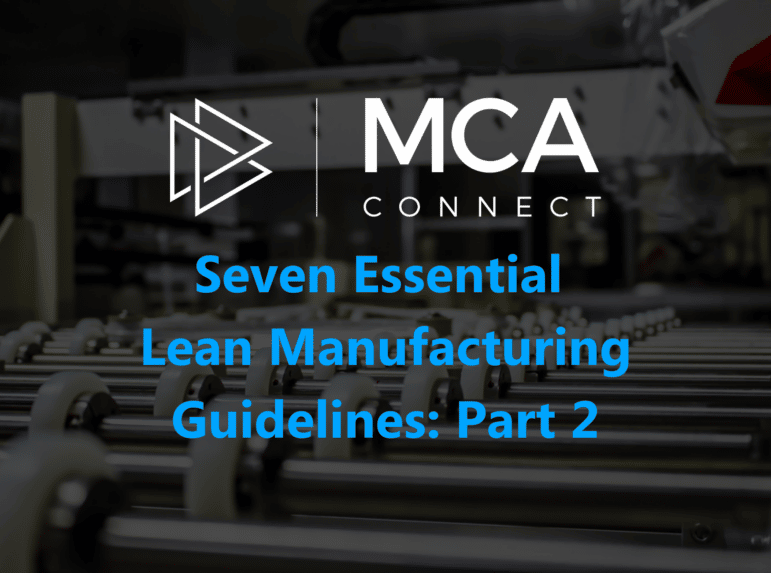Welcome to part two of our blog series, ‘Seven Essential Lean Manufacturing Guidelines’. All manufacturers know that lean manufacturing is an essential component of manufacturing excellence. This three-part blog series will outline seven essential guidelines for manufacturers to consider during the design of a future state value stream. These guidelines include:
- Produce to your takt time.
- Develop continuous flow wherever possible.
- Use supermarkets to control production where continuous flow does not extend upstream.
- Send the customer schedule to only one production process.
- Level the production mix by distributing the production of different products evenly over time at the pacemaker process.
- Level the production volume by releasing and withdrawing small, consistent increments of work at the pacemaker.
- Develop the ability to make “every part every day” (then every shift, then every hour, or pallet or pitch) upstream of the pacemaker process.
Part 1 of the blog series covered guidelines 1-3 and can be found here.
In this post, we’ll discuss sending the customer schedule to only one production process. We’ll also cover leveling the production mix by distributing the production of different products evenly over time at the pacemaker process.
4. Send the customer schedule to only one production process
Moving from Pull to Flow
The process where we move from pull to flow is called the pacemaker process, also known as the schedule point. The customer’s orders control the pacemaker production process and is the single point of scheduling for the entire value stream. Work gets launched at the schedule point and the rest of the value stream responds in flow downstream and pull upstream.
Optimizing the Pacemaker Process
The design guideline is to try to release customer-scheduled work at a single point. In simple operations that’s not hard to do. In high-mix operations, finding a single pacemaker can be challenging. There may not be a single process through which all work flows. You may end up with pacemaker processes by product family. There may be multiple independent production lines to build the total volume required, each of which has a pacemaker process.
Scheduling Pacemaker Processes
Just how do we schedule our pacemaker processes? If we go back to our first principle of production scheduling, while we launch work at the pacemaker or schedule point, that process may not be our overall capacity constraint (or bottleneck) and we may have material shortages that limit how much we can build. That means that we should not release work to the pacemaker processes without considering the capacity limits anywhere in the value stream – including considering the material availability not just of end products, but of every sub-assembly and raw material component as well. In high-mix manufacturers, here’s where lean manufacturing software is essential.
5. Level the production mix by distributing the production of different products evenly over time at the pacemaker process
Unconventional Thoughts on Batching
While it’s easier to schedule long runs of one product type to avoid changeovers, larger batches create serious problems for the rest of the lean manufacturing value stream. Larger batches increase the lead time to fulfill any order and make your operation less flexible.
Rather, we recommend you level out the product mix by spreading out the work as evenly as possible over time and running with as small a batch as you have capacity. While this is contrary at every level of conventional thinking, you should use all your capacity to run as many changeovers as possible to keep your batch size as small as possible.
Why Smaller Batches can be Better
Let’s say there’s a weekly production schedule and the pacemaker is producing three different products. We could accomplish our work by running each product once a week and incur only three changeovers. That would mean that we are producing in batches of 1.67 days with a lead time of over three days. If we can absorb the changeover time to run each product each day, then we have moved from three-day lead time to just one-day lead time. Do the math! That strategy can free up a lot cash tied up in inventory. If we can move that from eight hours to two hours, now we are have a four-hour lead time and may be able to move our entire operation to make to order.
Stay tuned!
Stay tuned for the third and final post of our blog series, ‘Seven Essential Lean Manufacturing Guidelines’. Next time, we’ll cover:
- Leveling the production volume by releasing and withdrawing small, consistent increments of work at the pacemaker
- Developing the ability to make “every part every day” (then every shift, then every hour, or pallet or pitch) upstream of the pacemaker process.
Contact us if you’d like to discuss more about lean manufacturing.
Author: Jay Feldman, Managing Director, Strategic Services


